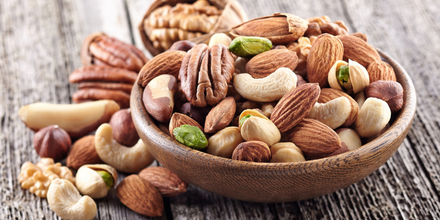Nuts are highly exalted as a healthy diet staple – peanuts, walnuts and pecans, just to name a few. How do they fit into your diet?
Nuts are seed kernels and usually have a hard shell that must be opened for the nut to be eaten. You see nuts often in salads, snacks and treats. Are they a great addition to your diet or are they overhyped?
What’s in a Nut?
Nuts may truly be a superfood. Although they are higher in calories, there are many benefits to each one.
In general, nuts are an excellent source of protein, higher in fat and lower in carbohydrates (each nut varies). They also contain a good amount of fiber. They can fit in a variety of meal plans and dishes, including those found in low-carbohydrate and Mediterranean diets. Besides their nutritional breakdown, nuts contain antioxidants which can protect your cells from damage. They have also been shown to reduce inflammation and can improve your cholesterol levels. Since they are a little higher in calories, be sure to watch your portion size!
Types of Nuts
- Peanuts: These famous nuts are actually in the legume family, but their nutrition matches that of a nut. Peanuts and natural peanut butter are both excellent healthy diet staples.
- Cashews: These are rich in monounsaturated fats, copper and magnesium. They have a creamy taste and are great for snacks.
- Pistachios: Pistachios are a great source of potassium and the antioxidants lutein and zeaxanthin. They typically come in a shell, which can sometimes be challenging to open, but they can also help slow down snacking so you can keep portion sizes in check.
- Walnuts: These are rich in Omega 3s, so they are a little higher in fat than some other nuts. Their polyunsaturated fats and antioxidants give them brain-boosting power.
- Almonds: Almonds are heart-healthy nuts that can help improve your cholesterol and reduce your risk for heart disease.
Adding Nuts in
There are a variety of easy ways to add this superfood into your diet. Start by eating a handful of nuts, a serving of nut butter or a nut-based oil such as peanut oil. Since nuts are higher in calories, don’t assume that a serving size is unlimited. Depending on your health goals, try starting with 1-2 servings a day. Eating them as a snack, adding them to a salad or putting them in a stir fry are easy ways to maximize their nutrition. Check out the salad recipe below.
Roasted Red Pepper and Pine Nut Salad
Source: Cooking Light
Ingredients:
- 2 tablespoons extra virgin olive oil
- 1 tablespoon red wine vinegar
- 1/8 teaspoon kosher salt
- 1/8 teaspoon ground red pepper
- 1 1/2 teaspoons chopped fresh oregano
- 2 cups loosely packed spring mix
- 2 cups loosely packed baby spinach
- 1/2 cup bottled roasted red peppers, drained and chopped
- 2 1/2 tablespoons roasted pine nuts
- 2 tablespoons crumbled feta cheese
Directions:
Combine oil, vinegar, salt, red pepper and oregano in a large bowl, stirring with a whisk. Add spring mix, spinach, and roasted bell peppers; toss gently to coat. Sprinkle salad with pine nuts and crumbled feta.






